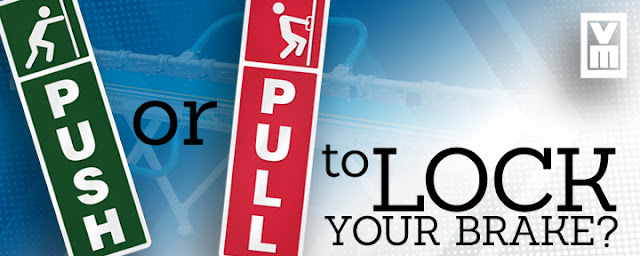Push or Pull – the debate rages on!
At Van Mark our goal is to build quality tools that can not
only last a lifetime but are also easy to live with. Typical bending brakes on
the market use either a push-to-lock or a pull-to-lock system. The unique cam-lock
design that we incorporate into most of our brakes utilizes a push-to-lock
design. We do this for a couple of very important reasons.
First, to allow for more space to work. When the
locking handle is pushed into place, it is now up and away from the user
revealing more space for the legs of your material that you are bending without
it bumping into the lock handles. This allows you to bend larger pieces in the
brake by flipping the material over and having the longer section pointing up
toward the lock handle. When a brake uses a pull-to-lock design, the handle is
pulled toward you while bending which can lead to the possibility of the handle
scratching or denting your material accidentally.
Second, the cam-lock design self-adjusts to the
material thickness when you lock it, and just like locking any siding brake
properly, it takes some muscle. And as we all learned in elementary school
science class, pushing a heavy object is easier than pulling one. So, we
designed our brakes to use a push-to-lock design to reduce the effort required
by the user. This can really help when you have a big project with a lot of
material that needs to be formed.
Because there are both styles of locking mechanisms on
bending brakes in the market, we often find that new users to a Van Mark brake might
need to take extra time breaking their old pull-to-lock habits. But the analogy
we use when discussing this with people is that it’s similar to driving a
rental car when you are on vacation. When you first hop into the car, you will
surely reach for controls that are in a different location than the car you
drive every day. But by the end of your vacation, your body has adapted to
where the controls are, and you are no longer making that mistake. Using a metal
brake is very similar. Changing to a push-to-lock motion can feel different at
first if you aren’t used to it, but the clumsiness quickly fades as you use the
Van Mark brake.
But, for those who have tried to adapt to the push-to-lock
method and just can’t seem to make it happen, Van Mark does offer the ability
to change your brake to a pull-to-lock design. But to be honest, you end up
losing both benefits mentioned above, which to us seems to negate the
engineering effort we put into the brake’s design. (read: we don’t recommend
it) It can be done, but it isn’t for the faint of heart, as you need to allocate
some time to the project if you choose to make the switch. But why limit
yourself like that when the brake is capable of so much more when configured as
a push-to-lock brake?
No matter which method you prefer, Van Mark cam-lock brakes can suit your preference, even though from where we sit, there really is no debate. Push-to-lock is the clear winner, and you can be too!


